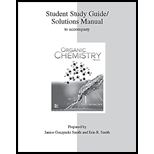
Concept explainers
Propose a structure consistent with each set of data.
a. Compound J: molecular ion at
b. Compound K: molecular ion at
Want to see the full answer?
Check out a sample textbook solution
Chapter 14 Solutions
ORGANIC CHEMISTRY-STUDY GUIDE PACKAGE
Additional Science Textbook Solutions
Essential Organic Chemistry (3rd Edition)
Chemistry: The Central Science (14th Edition)
Living by Chemistry
Thermodynamics, Statistical Thermodynamics, & Kinetics
General, Organic, & Biological Chemistry
Chemistry: An Introduction to General, Organic, and Biological Chemistry (12th Edition) - Standalone book
- Reaction of butanenitrile (CH3CH2CH2CN) with methylmagnesium bromide (CH3MgBr), followed by treatment with aqueous acid, forms compound G. G has a molecular ion in its mass spectrum at m/z = 86 and a base peak at m/z = 43. G exhibits a strong absorption in its IR spectrum at 1721 cm−1 and has the 1H NMR spectrum given below. What is the structure of G?arrow_forwardPropose a structure consistent with each set of spectral data: a. C4H8Br2: IR peak at 3000–2850 cm−1; NMR (ppm): 1.87 (singlet, 6 H) 3.86 (singlet, 2 H) b.C3H6Br2: IR peak at 3000–2850 cm−1; NMR (ppm): 2.4 (quintet) 3.5 (triplet) c. C5H10O2: IR peak at 1740 cm−1; NMR (ppm): 1.15 (triplet, 3 H) 2.30 (quartet, 2 H) 1.25 (triplet, 3 H) 4.72 (quartet, 2 H) d.C3H6O: IR peak at 1730 cm−1; NMR (ppm): 1.11 (triplet) 2.46 (multiplet) 9.79 (triplet)arrow_forwardReaction of butanenitrile (CH3CH2CH2CN) with methylmagnesium bromide (CH3MgBr), followed by treatment with aqueous acid, forms compound G. G has a molecular ion in its mass spectrum at m/z = 86 and a base peak at m/z = 43. G exhibits a strong absorption in its IR spectrum at 1721 cm−1 and has the 1H NMR spectrum given below. What is the structure of G? We will learn about the details of this reaction in Chapter 22.arrow_forward
- Propose a structure consistent with each set of data. C10H14: IR absorptions at 3150–2850, 1600, and 1500 cm−1arrow_forward(a) The 'H-NMR spectrum of cyclobutanone shows two signals - signal A at 3.00 ppm and signal B at 1.95 ppm. Give the multiplicity of each signal. cyclobutanone (b) When cyclobutanone is treated with D20 and NaOD, the only signal observable in the 1H-NMR is a singlet at 2.00 ppm. Explain why this is the case. [Note: Deuterium atoms do not display signals in the TH-NMR spectrum]arrow_forward15. Compound C has a molecular weight of 94.54 and the 1H-NMR spectrum shows four signals - a triplet at 3.81 ppm, a triplet at 3.63 ppm, a singlet at 2.19 ppm, and a triplet of triplets at 2.02 ppm. The mass, IR, and 13C-NMR spectra of compound C are shown below, they are also downloadable for closer inspection by clicking the link under the spectral data. Identify C and explain your reasoning. refer to picturearrow_forward
- Compound C has a molecular ion in its mass spectrum at 146 and a prominent absorption in its IR spectrum at 1762 cm-1. C shows the following 1H NMR spectral data: 1.47 (doublet, 3 H), 2.07 (singlet, 6 H), and 6.84 (quartet, 1 H) ppm. What is the structure of C?arrow_forwardplease help with this question. thank you. Given that compound X has a molecular formula of C6H10O2, gave three peaks in its 13C NMR spectrum (14, 63 and 158 ppm) and two peaks in its 1H NMR spectrum (1.4 ppm, triplet and 4.3 ppm, quartet), provide a structure for compound X and briefly explain.arrow_forwardcompound with the molecular formula C7H9N exhibits IR bands at 3450 cm-1 (medium, doublet), and 855 cm-1 (strong) and shows the following major mass spectral signals (m/z): 106 (base); 107 (M+, about 70% of base), 91 (40% of base), and 77 (about 20% of base). Deduce a reasonable structure from this data.arrow_forward
- Show the 13C NMR for the following compound and Explain each peak for formed in detail.arrow_forwardHow could you use chemical shift and integration data in 1H NMR spectroscopy to distinguish between CH3OCH2CH2OCH3 and CH3OCH2OCH3? The 1H NMR spectrum of each compound contains only singlets.arrow_forwardPropose a structure consistent with each set of spectral data: a.C6H14O: IR peak at 3600−3200 cm−1; NMR (ppm): 0.8 (triplet, 6 H) 1.5 (quartet, 4 H) 1.0 (singlet, 3 H) 1.6 (singlet, 1 H) b.C6H14O: IR peak at 3000−2850 cm−1; NMR (ppm): 1.10 (doublet, relative area = 6) 3.60 (septet, relative area = 1)arrow_forward
 Macroscale and Microscale Organic ExperimentsChemistryISBN:9781305577190Author:Kenneth L. Williamson, Katherine M. MastersPublisher:Brooks Cole
Macroscale and Microscale Organic ExperimentsChemistryISBN:9781305577190Author:Kenneth L. Williamson, Katherine M. MastersPublisher:Brooks Cole
